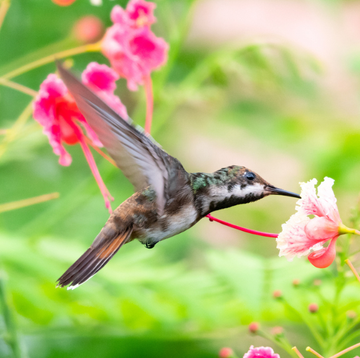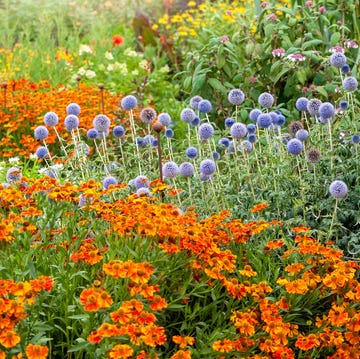- Bees are essential to our ecosystem, yet they've been on the decline for years.
- Without them, our yards would lack many of the fruits and flowers we see today.
- Learn how to attract bees to your garden with tips from experts.
Bees are incredibly important to our ecosystem, aiding in the production of fruits and seeds through pollination. Yet despite the significant role these insects play in our gardens and beyond, honey bee colonies have been on the decline for years due to habitat loss, pesticides and climate change, among other causes.
Over the past decade, honey bee colony annual losses have ranged from 40-50%. This year, according to entomologists at Washington State University, colony losses could reach 60-70%.
"Without bees and other pollinators, we wouldn't have much of the floral or fruit diversity that we see in the world," says Laura Leger, who has her Ph.D. in Entomology from UC Riverside. "Our diets would only consist of wind-pollinated products like grain. And our backyards would not be nearly as vibrant with all of the beautiful and diverse colors that flowering plants produce."
By creating a welcoming environment for these essential creatures, you're not only helping your garden thrive, you're supporting the entire bee population. We spoke to experts for their best advice on how to attract bees to your garden. Read on for more on how you can do your part from the comfort of your own backyard.
1. Plant diverse flowers.
Think flowers of all shapes, sizes and colors. The more you can plant, the better. "Flowers are food for bees! The more diverse your garden is, the more diverse your pollinators can be. Some flowers, like sunflowers, have even been shown to be helpful in preventing or treating certain diseases in bees," says Leger.
2. Go native.
"Bees need nectar and pollen to feed themselves and their babies. Plant a variety of native flowering plants — trees, shrubs, annuals and perennials — that bloom throughout the growing season. In the spring, native oaks, maples and fruit trees can be a beautiful choice. One tree can have a meadow’s worth of flowers! In the late summer and fall, locally native asters and goldenrods can provide beautiful colors for your garden and food for many bees," says Laura Rost, national coordinator at Bee City USA.
If you're not sure which flowers to plant, Rost suggests checking out Xerces Society's pollinator plant lists for every area of the country.
3. Garden with wildlife in mind.
Of course, you should feel proud of your garden and enjoy spending time out there, but it's important to consider the bigger picture, too. Your garden should also serve pollinators and other wildlife as best it can, even if that means planting a few flowers or trees you wouldn't normally choose.
4. Limit pesticides.
"Pesticides are one of the leading causes of bee declines. Pesticide residues can persist on plants and can affect bees long after their application," says Leger. Still, it can be frustrating to see pests eating all of your fruits and veggies you worked hard to grow. Luckily, there are natural pesticide alternatives you can try instead.
"Embracing alternative pest control practices like encouraging natural enemies (ladybugs, praying mantises, etc.) and using insecticidal soap or cayenne pepper can help deter pests while keeping your plants safe for bees to feed from," she says.
5. Provide a safe habitat.
While you might think all bees come home to a large nest after a long day of foraging, experts say that isn't always the case.
"Bees nest in a diversity of ways. Some make nests in the soil, some in tree cavities and some are cavity nesters and use hollowed out branches or twigs to make their nests. Many of these bees are also solitary, meaning they do all the work of laying eggs, as well as providing shelter and food on their own. Providing bee hotels or leaving that pile of scrap wood in your yard can promote nesting. If they nest in your garden, they are likely pollinating your garden too," says Leger.
6. Get your community involved.
While your own garden is a great place to start, spreading the word is the next step. "In order to save the bees, it’s important to get your community involved," says Rost. Share your favorite native flowers with neighbors or put a yard sign encouraging others to create a pollinator habitat on their own property.
Laura Millar (she/her) is the assistant lifestyle editor for Good Housekeeping, where she covers home design. Prior to joining Good Housekeeping in 2024, she wrote for NBC's TODAY.com, where she covered everything from entertainment news to pop culture updates.
















